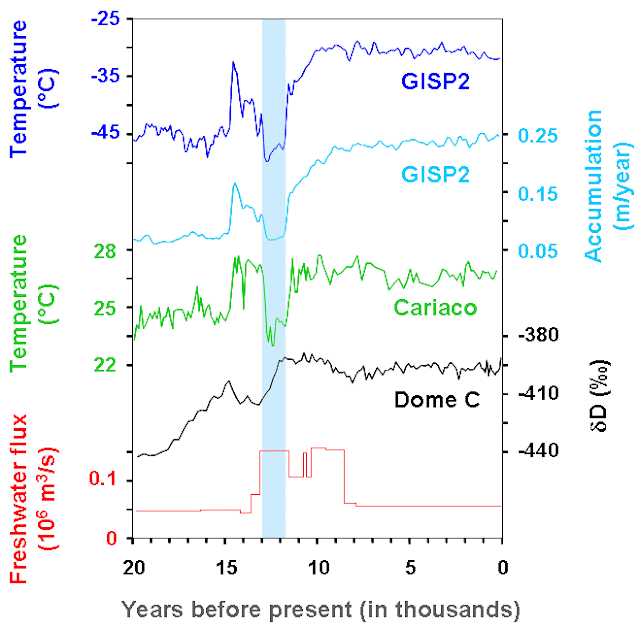The Younger Dryas and Abrupt Climate Changes
We are often conditioned to think climate changes that occur naturally are always slow and gradual. However, the geologic evidence we have shows that there major exceptions to this general rule. Perhaps the most widely-cited is the onset of the Younger Dryas - a well known abrupt climate change in which temperatures changed rapidly, perhaps by 10°C in a few decades, with completely natural causes. The episode is most easily identified in the GISP2 Greenland ice core record. According to the ice core record, cooling began about 14,500 years ago, followed by an abrupt cooling event about 13,000 years ago. That cooling period ended just as abruptly 11,500 year ago, and recovery from the last glaciation continued into the Holocene. Abrupt shifts in temperatures in agreement with these time frames were also seen in other places around the globe, including the Cariaco Basin in Venezuela and varved lake sediments in Europe. This raises a couple interesting questions: 1) what caused the abrupt onset and ending of the Younger Dryas, and 2) how extensive was it?
The biggest clue to answering the first question comes from answering the second. The Dome C ice core in Antarctica shows gradual warming during the entire time period of the Younger Dryas, and temperatures at Dome C stabilized when the Younger Dryas ended. So clearly the sudden cooling and warming was not global. But it's this clue that has formed what is likely the most compelling hypothesis explaining the Younger Dryas. As the globe was warming following the last glacial maximum (LGM), the Laurentide ice sheet was melting, adding fresh water to the ocean in large quantities. One suggestion is that meltwater was suddenly rerouted from the Mississippi to the St. Lawrence River. If that happened, fresh water would have taken a more northerly route, lowering the salinity of the North Atlantic ocean surface. This would have the effect of slowing down thermohaline circulation patterns. This slow down of thermohaline circulation would have prevented warmer waters from flowing from the South Atlantic to the North Atlantic, and the resulting build of up heat in the oceans of the southern hemisphere would cause the gradual warming in Antarctica observed in the Dome C ice core. When the flux of meltwater from the Laurentide ice sheet meltwater stopped flowing northward along the St. Lawrence, this would have abruptly stopped, and normal circulation patterns would be restored. Greenland Temperatures would abruptly rise and return to its continued recovery from the LGM. Antarctic warming would then be expected to cease, which is also shown in the Dome C proxy record.[1]
While it seems clear that some rapid reorganization of the Atlantic thermohaline circulation is necessary to explain the Younger Dryas, it's not absolutely clear that it's necessary for there to be an external trigger to initiate it. One paper from 2010[4] suggests that the Younger Dryas may occur just like the Dansgaarde-Oeschger (DO) events, about 24 or so of these events can be found in the Greenland ice cores. During these events, fresh water pools at the ocean surface, leading to abrupt changes in the climate around Greenland that then has effects elsewhere around the globe. And while a sudden shut-down of Atlantic thermohaline circulation may be necessary to cause the Younger Dryas, it may not be sufficient to cause the event on its own. It's possible that a combination of processes including negative radiative forcings and a change in atmospheric circulation patterns are also necessary to contribute to the Younger Dryas cooling event.[5]
There is still much to be discovered about the causes and extent of the Younger Dryas. But there are a couple things we can say from what we know so far. First, sudden climate changes can and do occur naturally, so we can't argue simply from the fact that current warming is sudden or abrupt that it must be human-caused. But secondly, sudden and abrupt climate changes do have causes, and it's the job of scientists to find compelling evidence that can explain abrupt climate changes. We know, or instance, that there has been no rerouting of glacial meltwater flow that can explain current warming. And we do have compelling evidence that human activity is causing current warming. The fact that natural climate changes can occur abruptly is not itself an argument that current warming has natural causes.
Note:
Recently scientists discovered a 31 km-wide crater under the Greenland Ice Sheet, indicating a 1.5 km asteroid or comet impact that at least initially was dated to about 12,800 yeas ago,[2] That initial date appears to be incorrect, though,; it is now thought to have been an older impact. But it's possible there was some not-yet-discovered trigger that caused a flood of fresh water into the Atlantic that initiated the Younger Dryas event. But the Younger Dryas event may be at least partly responsible for the extinction of megafauna and sudden decline of human populations in North America.[3]
References:
[1] NOAA. The Younger Dryas. The Younger Dryas is one of the most well-known examples of abrupt change. https://www.ncei.noaa.gov/sites/default/files/2021-11/3%20The%20Younger%20Dryas%20-FINAL%20NOV%20%281%29.pdf
[2] Paul Voosen. Massive crater under Greenland's ice points to climate-altering impact in the time of humans. Science Nov. 14, 2018.
https://www.sciencedirect.com/science/article/abs/pii/S027737911000051X?via%3Dihub
[5] Hans Renssen, Aurélien Mairesse, Hugues Goosse, Pierre Mathiot, Oliver Heiri, et al..Multiple causes of theYounger Dryas cold period.Nature Geoscience, 2015, 8(12), pp.946-949. 10.1038/ngeo2557. hal-03218176




Comments
Post a Comment